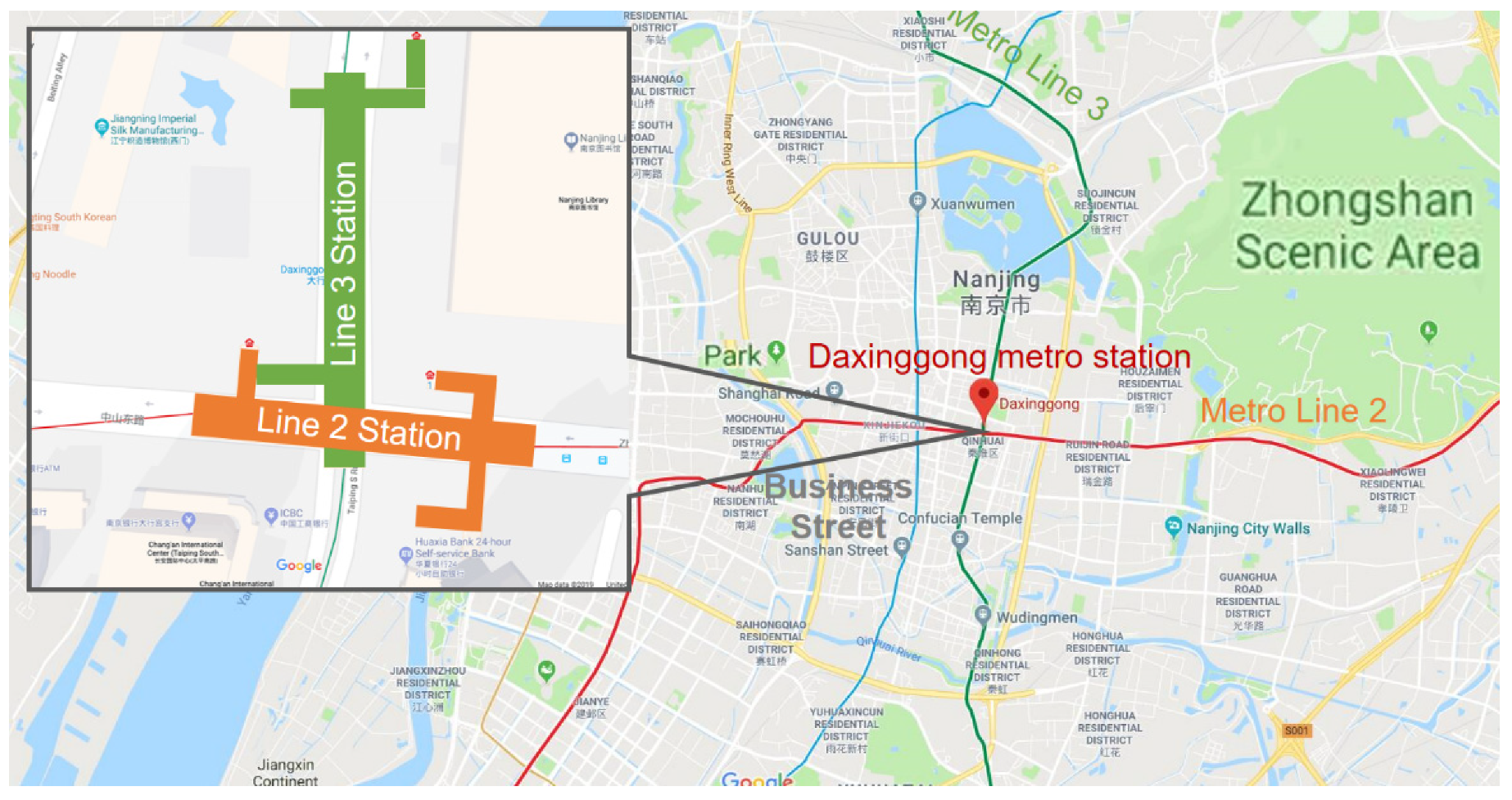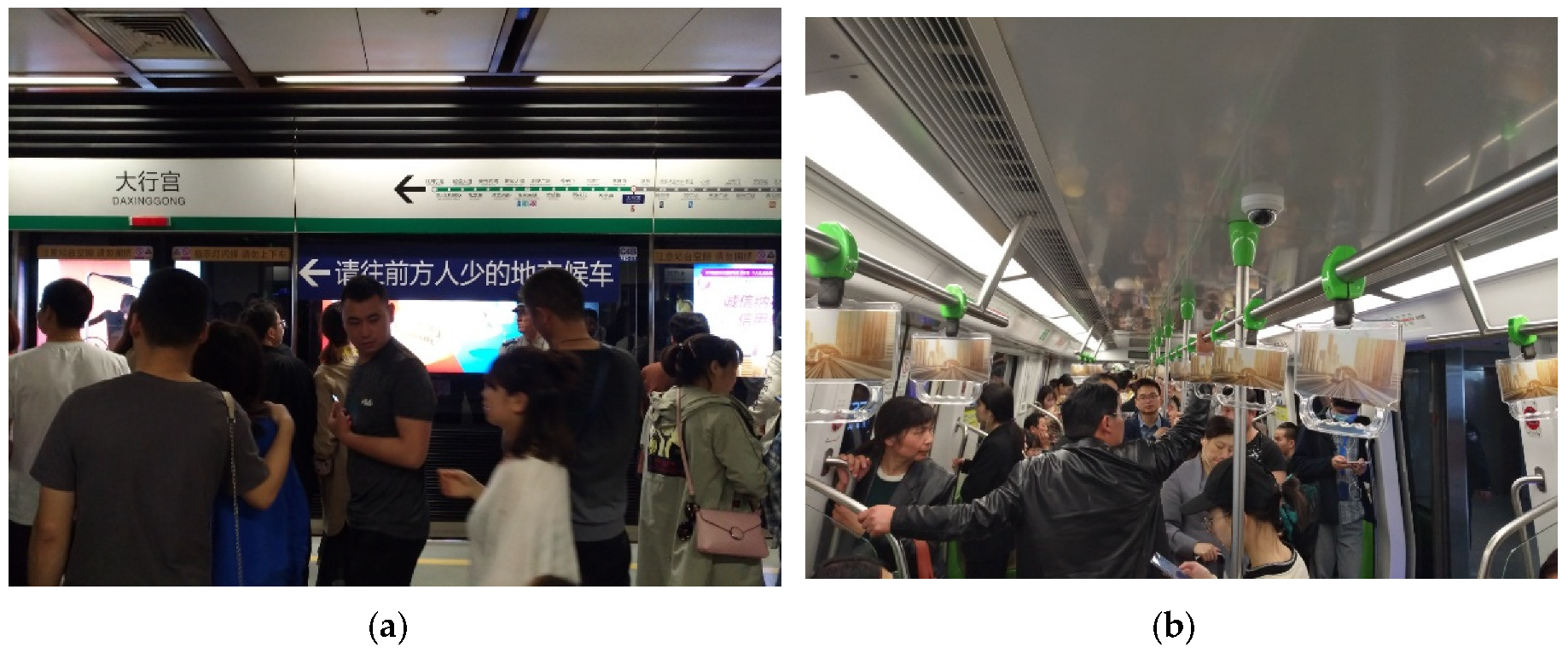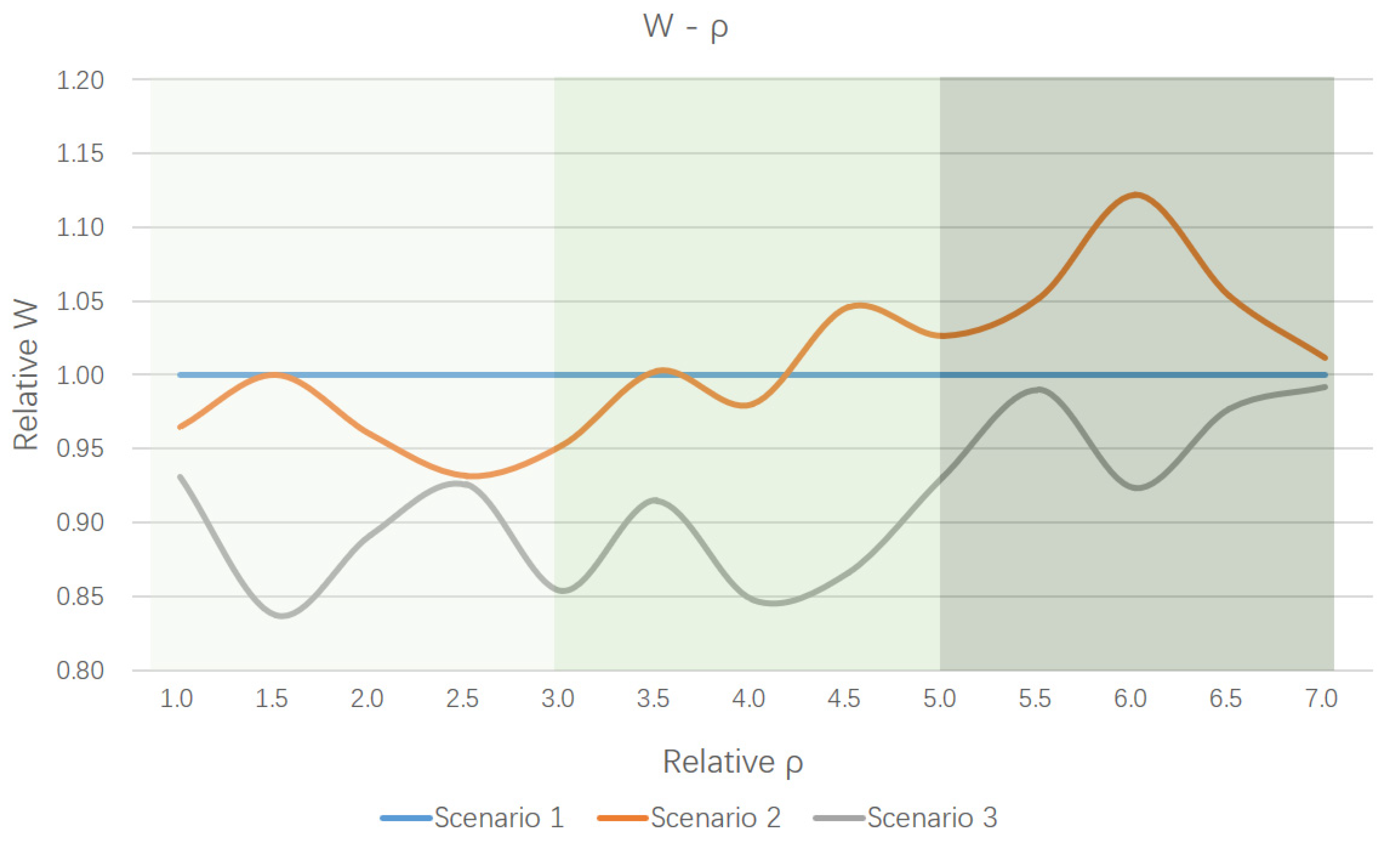Optimization of Metro Passenger Organizing of Alighting and Boarding Processes: Simulated Evidence from the Metro Station in Nanjing, China
Abstract
:1. Introduction
1.1. Background
1.2. Influencing Factors of Dwell Time
1.3. Analyzing Methods of the Alighting and Boarding Process
2. Model Description
2.1. Classic Social Force Model
2.2. Model Improvement
2.2.1. Definition of a Friction Surface
2.2.2. Algorithm of the Friction Surface
2.3. Definition of Indicators
2.3.1. Social Force Work
2.3.2. Unit Flow Rate
2.3.3. Average Delay
2.4. Model Operation
3. Simulation Preparation
3.1. Data Collection
3.2. Passenger Organizing Modes
- Scenario 1: passengers alight through the middle of each door while boarding on the two sides of the door, which is shown in Figure 10.
- Scenario 2: passengers alight from the left side of each door while boarding on the right side of the door, which is shown in Figure 11.
- Scenario 3: passengers alight from different doors than those used for boarding, which is shown in Figure 12.
- Passengers need to compete for the doorway to pass through the doors.
- Passengers need to compete for space to settle down in the vehicle or platform after passing through the doors.
4. Results and Discussion
- (1)
- A full scenario was simulated both in the environment mock-up and the auto-agent generation. The simulation scenario was expanded from a single door to a whole vehicle and the corresponding platform, and inactive passengers who do not participate in the alighting and boarding process were added. This made the simulation more integrated, and the needs of different passenger organizing modes could also be met.
- (2)
- The existing social force model was improved by differentiating between passengers’ positions. They were divided into two groups: On friction surfaces or not. Passengers in different groups follow different rules to move. In this way, the existing social force model was improved in terms of both rationality and accuracy.
- (3)
- In the process of analyzing the simulation results, social force work was used to quantify the subjective feelings of the physical energy consumption and the difficulty degree in completing the alighting and boarding process, so as to establish a more comprehensive evaluation index system for the evaluation of the efficiency and LOS of passenger organizing.
Author Contributions
Funding
Acknowledgments
Conflicts of Interest
References
- Rana, M.; Parves, M. Urbanization and sustainability: Challenges and strategies for sustainable urban development in bangladesh. Environ. Dev. Sustain. 2011, 13, 237–256. [Google Scholar] [CrossRef]
- Du, C.; Xiao, M.; Zhou, X. Research on urban public transport status and countermeasure of yinzhou district in ningbo city. In Proceedings of the 2015 Ninth International Conference on Management Science and Engineering Management, Karlsruhe, Germany, 21–23 July 2015; Volume 362, pp. 471–481. [Google Scholar]
- Yang, X.; Chen, A.; Ning, B.; Tang, T. Bi-objective programming approach for solving the metro timetable optimization problem with dwell time uncertainty. Transp. Res. Part E Logist. Transp. Rev. 2017, 97, 22–37. [Google Scholar] [CrossRef]
- Pretty, R.L. The planning of bus transport for developling urban form. Aust. Road Res. 1988, 18, 82–88. [Google Scholar]
- Harris, N.G. Train boarding and alighting rates at high passenger loads. J. Adv. Transp. 2010, 40, 249–263. [Google Scholar] [CrossRef]
- Jia, N.; Wang, Y. A Model of High-Density Passenger Boarding and Alighting in Urban Rail Transit Station; Springer: Singapore, 2018; pp. 779–789. [Google Scholar]
- Levinson, H.S. Analyzing Transit Travel Time Performance. Transp. Res. Rec. 1983, 915, 1–6. [Google Scholar]
- Guenthner, R.P.; Sinha, K.C. Modeling Bus Delays Due to Passenger Boardings and Alightings. Transp. Res. Rec. 1983, 915, 7–13. [Google Scholar]
- Heinz, W. Passenger Service Times on Trains Theory, Measurements, and Models. Ph.D. Thesis, Royal Institute of Technology, Stockholm, Sweden, 2003. [Google Scholar]
- Harris, N.G.; Graham, D.J.; Anderson, R.J.; Li, H. The Impact of Urban Rail Boarding and Alighting Factors. In Proceedings of the Transportation Research Board 93rd Annual Meeting, Washington, DC, USA, 12–16 January 2014. [Google Scholar]
- Sun, L.; Tirachini, A.; Axhausen, K.W.; Erath, A.; Lee, D.-H. Models of bus boarding and alighting dynamics. Transp. Res. Part A Policy Pract. 2014, 69, 447–460. [Google Scholar] [CrossRef] [Green Version]
- Coxon, S.; Chandler, T.; Wilson, E. Testing the efficacy of platform and train passenger boarding, alighting and dispersal through innovative 3d agent-based modelling techniques. Urban Rail Transit 2015, 1, 87–94. [Google Scholar] [CrossRef]
- Shi, X.; Ye, Z.; Shiwakoti, N.; Tang, D.; Lin, J. Examining effect of architectural adjustment on pedestrian crowd flow at bottleneck. Phys. A Stat. Mech. Appl. 2019, 522, 350–364. [Google Scholar] [CrossRef] [Green Version]
- Ji, Y.; Gao, L.; Chen, D.; Ma, X.; Zhang, R. How does a static measure influence passengers’ boarding behaviors and bus dwell time? Simulated evidence from nanjing bus stations. Transp. Res. Part A Policy Pract. 2018, 110, 13–25. [Google Scholar] [CrossRef]
- Fernandez, R.; Zegers, P.; Weber, G.; Tyler, N. Effect of Door Width, Platform Height and Fare Collection on Bus Dwell Time. A Laboratory Study. In Proceedings of the World Conference on Transport Research, Lisbon, Portugal, 11–15 July 2010. [Google Scholar]
- Schelenz, T.; Suescun, Á.; Wikström, L.; Karlsson, M. Passenger-centered design of future buses using agent-based simulation. Procedia Soc. Behav. Sci. 2012, 48, 1662–1671. [Google Scholar] [CrossRef]
- Schelenz, T.; Suescun, A.; Karlsson, M.; Wikstrom, L. Decision making algorithm for bus passenger simulation during the vehicle design process. Transp. Policy 2013, 25, 178–185. [Google Scholar] [CrossRef]
- Rexfelt, O.; Schelenz, T.; Karlsson, M.; Suescun, A. Evaluating the effects of bus design on passenger flow: Is agent-based simulation a feasible approach? Transp. Res. Part C Emerg. Technol. 2014, 38, 16–27. [Google Scholar] [CrossRef]
- Liu, Y.; Liu, Z.; Jia, R. Deeppf: A deep learning based architecture for metro passenger flow prediction. Transp. Res. Part C Emerg. Technol. 2019, 101, 18–34. [Google Scholar] [CrossRef]
- Thoreau, R.; Holloway, C.; Bansal, G.; Gharatya, K.; Roan, T.-R.; Tyler, N. Train design features affecting boarding and alighting of passengers. J. Adv. Transp. 2016, 50, 2077–2088. [Google Scholar] [CrossRef] [Green Version]
- Li, Y.; Wang, Y. Urban rail transit platform passenger alighting and boarding movement and experiment research. In Proceedings of the International Conference on Electrical and Information Technologies, Changsha, China, 20–22 October 2017; pp. 889–898. [Google Scholar]
- Seriani, S.; Fernandez, R. Pedestrian traffic management of boarding and alighting in metro stations. Transp. Res. Part C Emerg. Technol. 2015, 53, 76–92. [Google Scholar] [CrossRef]
- Cheng, L.; Chen, X.; Yang, S.; Cao, Z.; De Vos, J.; Witlox, F. Active travel for active ageing in china: The role of built environment. J. Transp. Geogr. 2019, 76, 142–152. [Google Scholar] [CrossRef]
- Yuan, Y.; Yang, M.; Wu, J.; Rasouli, S.S.; Lei, D. Assessing bus transit service from the perspective of elderly passengers in harbin, china. Int. J. Sustain. Transp. 2019, 16, 1–16. [Google Scholar] [CrossRef]
- Kamizuru, T.; Tomii, N. Multi-agent model based simulation of passenger flow on a shinkansen station platform in the peak season. IEEJ Trans. Ind. Appl. 2014, 134, 750–759. [Google Scholar] [CrossRef]
- Tirachini, A. Bus dwell time: The effect of different fare collection systems, bus floor level and age of passengers. Transportmetrica 2013, 9, 28–49. [Google Scholar] [CrossRef]
- Fernandez, R.; Zegers, P.; Weber, G.; Tyler, N. Influence of platform height, door width, and fare collection on bus dwell time: Laboratory evidence for santiago de chile. Transp. Res. Rec. 2010, 2143, 59–66. [Google Scholar] [CrossRef]
- Gu, X.; Abdelaty, M.; Xiang, Q.; Cai, Q.; Yuan, J. Utilizing uav video data for in-depth analysis of drivers’ crash risk at interchange merging areas. Accid. Anal. Prev. 2019, 123, 159–169. [Google Scholar] [CrossRef]
- Henderson, L.F. The statistics of crowd fluids. Nature 1971, 229, 381–383. [Google Scholar] [CrossRef] [PubMed]
- Hughes, R.L. The flow of human crowds. Annu. Rev. Fluid Mech. 2003, 35, 169–182. [Google Scholar] [CrossRef]
- Muramatsu, M.; Irie, T.; Nagatani, T. Jamming transition in pedestrian counter flow. Phys. A Stat. Mech. Appl. 1999, 267, 487–498. [Google Scholar] [CrossRef]
- Blue, V.J.; Adler, J.L. Cellular automata microsimulation for modeling bi-directional pedestrian walkways. Transp. Res. Part B Methodol. 2001, 35, 293–312. [Google Scholar] [CrossRef]
- Cheng, Q.; Liu, Z.; Szeto, W.Y. A cell-based dynamic congestion pricing scheme considering travel distance and time delay. Transp. B Transp. Dyn. 2019, 7, 1286–1304. [Google Scholar] [CrossRef]
- Qi, Z.; Baoming, H.; Dewei, L. Modeling and simulation of passenger alighting and boarding movement in beijing metro stations. Transp. Res. Part C Emerg. Technol. 2008, 16, 635–649. [Google Scholar]
- Lu, Y. Passenger Alighting and Boarding Model and Simulation Based on Cellular Automata. Master’ Thesis, Beijing Jiaotong University, Beijing, China, 2017. [Google Scholar]
- Helbing, D.; Molnar, P. Social force model for pedestrian dynamics. Phys. Rev. E 1995, 51, 4282–4286. [Google Scholar] [CrossRef] [Green Version]
- Helbing, D.; Farkas, I.J.; Vicsek, T. Simulating dynamical features of escape panic. Nature 2000, 407, 487–490. [Google Scholar] [CrossRef] [PubMed] [Green Version]
- Johansson, A.; Helbing, D.; Shukla, P.K. Specification of the social force pedestrian model by evolutionary adjustment to video tracking data. Adv. Complex Syst. 2007, 10, 271–288. [Google Scholar] [CrossRef]
- Johansson, A.; Helbing, D. Analysis of Empirical Trajectory Data of Pedestrians; Springer: Berlin/Heidelberg, Germany, 2010; pp. 203–214. [Google Scholar]
- Apel, M. Simulation of Pedestrian Flows Based on the Social Force Model Using the Verlet Link Cell Algorithm. Master’ Thesis, Poznan University of Technology, Poznan, Poland, 2004. [Google Scholar]
- Verlet, L. Computer “experiments” on classical fluids. I. Thermodynamical properties of lennard-jones molecules. Phys. Rev. 1967, 159, 98–103. [Google Scholar] [CrossRef]
- Lakoba, T.I.; Kaup, D.J.; Finkelstein, N.M. Modifications of the helbing-molnár-farkas-vicsek social force model for pedestrian evolution. Simulation 2005, 81, 339–352. [Google Scholar] [CrossRef]
- Ding, Q.; Wang, X.; Shan, Q.; Zhang, X. Modeling and simulation of rail transit pedestrian flow. J. Transp. Syst. Eng. Inform. Technol. 2011, 11, 99–106. [Google Scholar] [CrossRef]
- Rudloff, C.; Bauer, D.; Matyus, T.; Seer, S. Mind the gap: Boarding and alighting processes using the social force paradigm calibrated on experimental data. In Proceedings of the International Conference on Intelligent Transportation Systems, Washington, DC, USA, 5–7 October 2011; pp. 353–358. [Google Scholar]
- Moussaid, M.; Helbing, D.; Theraulaz, G. How simple rules determine pedestrian behavior and crowd disasters. Proc. Natl. Acad. Sci. USA 2011, 108, 6884–6888. [Google Scholar] [CrossRef] [PubMed] [Green Version]
- Eysenck, H.J.; Lewin, K. Field theory in social science. Br. J. Sociol. 1952, 3, 371. [Google Scholar] [CrossRef]
- Guo, R. Simulation of spatial and temporal separation of pedestrian counter flow through a bottleneck. Phys. A Stat. Mech. Appl. 2014, 415, 428–439. [Google Scholar] [CrossRef]
- Xue, Y.; Li, C.; Huanhuan, T.; Liyun, D. Experimnts of unidirectional and bidirectional pedestrian flows through a bottleneck in a channel. J. Shanghai Univ. 2014, 21, 8. [Google Scholar]
- Hart, P.E. The condensed nearest neighbor rule. IEEE Trans. Inf. Theory 1968, 14, 515–516. [Google Scholar] [CrossRef]
- Zhang, M.; Zhou, Z. Ml-knn: A lazy learning approach to multi-label learning. Pattern Recognit. 2007, 40, 2038–2048. [Google Scholar] [CrossRef]
- Minetti, A.E.; Ardigo, L.P.; Reinach, E.; Saibene, F. The relationship between mechanical work and energy expenditure of locomotion in horses. J. Exp. Biol. 1999, 202, 2329–2338. [Google Scholar] [PubMed]
- Zilbergleit, A.S. Uniform asymptotic expansions of some definite integrals. Ussr Comput. Math. Math. Phys. 1976, 16, 36–44. [Google Scholar] [CrossRef]
- Nakamura, K. The spatial relationship between pedestrian flows and street characteristics around multiple destinations. Iatss Res. 2016, 39, 156–163. [Google Scholar] [CrossRef] [Green Version]
- Pan, Y.; Chen, S.; Qiao, F.; Ukkusuri, S.V.; Tang, K. Estimation of real-driving emissions for buses fueled with liquefied natural gas based on gradient boosted regression trees. Sci. Total Environ. 2019, 660, 741–750. [Google Scholar] [CrossRef] [PubMed]
- Li, C.; Gao, X.; He, B.; Wu, J.; Wu, K. Coupling coordination relationships between urban-industrial land use efficiency and accessibility of highway networks: Evidence from beijing-tianjin-hebei urban agglomeration, china. Sustainability 2019, 11, 1446. [Google Scholar] [CrossRef]
- Xu, T.; Zhang, M.; Aditjandra, P. The impact of urban rail transit on commercial property value: New evidence from wuhan, china. Transp. Res. Part A Policy Pract. 2016, 91, 223–235. [Google Scholar] [CrossRef]
- Sorialara, J.A. Handbook on transport and urban planning in the developed world. Transp. Rev. 2016, 36, 816–817. [Google Scholar] [CrossRef]















| Number of Friction Surfaces | Unit Flow Rate (peds/s) | Average Delay (s) | |
|---|---|---|---|
| Scenario 1 | 2 | 3.53 | 2.24 |
| Scenario 2 | 1 | 4.00 | 2.10 |
| Scenario 3 | 0 | 4.93 | 1.84 |
| Low Density | Mid Density | High Density | |||
|---|---|---|---|---|---|
| Scenario 1 | Unit flow rate (peds/s) | Mean | 3.15 | 3.78 | 3.64 |
| S.D. | 0.23 | 0.28 | 0.40 | ||
| Delay (s) | Mean | 1.44 | 1.76 | 2.60 | |
| S.D. | 0.34 | 0.14 | 0.61 | ||
| Scenario 2 | Unit flow rate (peds/s) | Mean | 3.79 | 4.16 | 4.07 |
| S.D. | 0.42 | 0.37 | 0.41 | ||
| Delay (s) | Mean | 1.66 | 1.91 | 2.34 | |
| S.D. | 0.33 | 0.33 | 0.35 | ||
| Scenario 3 | Unit flow rate (peds/s) | Mean | 5.59 | 5.36 | 4.67 |
| S.D. | 0.39 | 0.62 | 0.33 | ||
| Delay (s) | Mean | 1.35 | 1.76 | 1.99 | |
| S.D. | 0.38 | 0.18 | 0.19 |
| Scenario | 3 | 2 | 1 |
|---|---|---|---|
| Number of the friction surfaces | 0 | 1 | 2 |
| Competitiveness gap | 1 | 0 |
© 2019 by the authors. Licensee MDPI, Basel, Switzerland. This article is an open access article distributed under the terms and conditions of the Creative Commons Attribution (CC BY) license (http://creativecommons.org/licenses/by/4.0/).
Share and Cite
Yu, J.; Ji, Y.; Gao, L.; Gao, Q. Optimization of Metro Passenger Organizing of Alighting and Boarding Processes: Simulated Evidence from the Metro Station in Nanjing, China. Sustainability 2019, 11, 3682. https://doi.org/10.3390/su11133682
Yu J, Ji Y, Gao L, Gao Q. Optimization of Metro Passenger Organizing of Alighting and Boarding Processes: Simulated Evidence from the Metro Station in Nanjing, China. Sustainability. 2019; 11(13):3682. https://doi.org/10.3390/su11133682
Chicago/Turabian StyleYu, Jiajie, Yanjie Ji, Liangpeng Gao, and Qi Gao. 2019. "Optimization of Metro Passenger Organizing of Alighting and Boarding Processes: Simulated Evidence from the Metro Station in Nanjing, China" Sustainability 11, no. 13: 3682. https://doi.org/10.3390/su11133682




